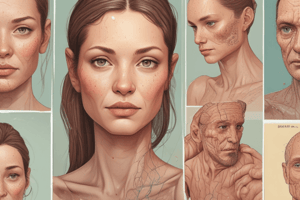Podcast
Questions and Answers
What condition is characterized by yellow crusts and erosions on the skin and is the most common type of impetigo?
What condition is characterized by yellow crusts and erosions on the skin and is the most common type of impetigo?
- Cellulitis
- Nonbullous impetigo (correct)
- Ecthyma
- Bullous impetigo
Which organism is primarily responsible for bullous impetigo?
Which organism is primarily responsible for bullous impetigo?
- Pasteurella multocida
- Haemophilus influenzae
- Staphylococcus aureus (correct)
- Streptococcus pyogenes
What describes the proper treatment for cellulitis?
What describes the proper treatment for cellulitis?
- Shaving the affected area
- Application of warm compresses only
- Only topical antibiotics
- Aggressive antibiotic treatment and covering affected areas (correct)
What is a common complication of severe cellulitis?
What is a common complication of severe cellulitis?
Which of the following statements about streptococcus infections is correct?
Which of the following statements about streptococcus infections is correct?
What is the duration of treatment for toenail infections with terbinafine?
What is the duration of treatment for toenail infections with terbinafine?
Which of the following is NOT a differential diagnosis for tinea manuum?
Which of the following is NOT a differential diagnosis for tinea manuum?
What is a key clinical feature of cutaneous candidiasis?
What is a key clinical feature of cutaneous candidiasis?
Which statement regarding the treatment of fungal infections with itraconazole is correct?
Which statement regarding the treatment of fungal infections with itraconazole is correct?
What is a common clinical feature shared by both tinea manuum and tinea pedis?
What is a common clinical feature shared by both tinea manuum and tinea pedis?
Flashcards are hidden until you start studying
Study Notes
Pathophysiology & Management of Skin Conditions
-
Tinea Manuum (Fungal Infection of the Hand)
- Acute stage: blisters on red areas of hands.
- Chronic stage: dry scaly patches.
- Associated with "1 hand 2 feet" syndrome, often linked to tinea pedis.
-
Management of Tinea
- Terbinafine (Lamisil) 250 mg once daily for 6 weeks for fingernails, 12 weeks for toenails.
- Pulse itraconazole (Sporanox) 200 mg twice daily for 7 days, followed by 3 weeks off (2 pulses for fingernails, 3 for toenails).
Differential Diagnosis
-
Skin Conditions Misdiagnosed as Fungal Infections
- Dyshidrotic dermatitis
- Allergic contact dermatitis (primarily on dorsum/heel)
- Atopic dermatitis
- Erythrasma and intertrigo (interdigital)
- Psoriasis (can occur on soles or interdigital spaces)
-
Other Conditions to Consider
- Lichen planus
- Trauma to skin
Cutaneous Candidiasis
- Causative Agent: Candida albicans, normally found in mouth, vagina, and lower GIT.
- Infection Characteristics:
- Affects only outer layers of skin/mucous membranes.
- Presentation: red, macerated patches with a glistening surface and scaling at the border.
- Notable feature: presence of ‘satellite’ pustules beyond the main infection.
Impetigo Overview
-
Non-Bullous Impetigo
- Most common form, presents with yellow crusts and erosions.
- Contagious, transmitted through skin contact, especially in children.
-
Bullous Impetigo
- Caused exclusively by Staphylococcus Aureus.
- Characterized by mildly irritating blisters that erode rapidly.
-
Ulcerative Lesions
- Most commonly observed in Aboriginal communities, distinguishes with significant crusting and ulceration.
Cellulitis and Abscesses
-
Cellulitis
- Bacterial infection of dermis and subcutaneous tissues.
- Common organisms: Staphylococcus Aureus and Group A Streptococcus.
- Symptoms: painful, raised erythematous areas with possible blistering.
-
Abscesses
- Superficial infections of hair follicles leading to boils (furuncles) or carbuncles (cluster of boils).
Necrotizing Fasciitis
- Definition: A medical emergency requiring radical debridement.
- Causes: Group A Streptococcus, Staphylococcus Aureus, Vibrio, Clostridium.
- Symptoms: Brownish-red inflammatory areas, rapidly expanding margins, and systemic toxicity.
Mycobacterial Infections
- Leprosy: Affects skin and nerves, presenting in tuberculoid and lepromatous forms.
Skin Manifestations of Metabolic Diseases
- Jaundice: Caused by elevated bilirubin, yellow breakdown product of heme catabolism.
- Symptoms: Yellowing of skin and eyes, brown color in feces.
Fractures and Musculoskeletal Emergencies
- Types of Fractures:
- Open (compound) and closed fractures, dislocations, and associated neurovascular compromise.
- Splinting: Reduces pain, bleeding, and risk of further injury.
Coagulation Disorders
- Von Willebrand’s Deficiency: Characterized by inadequate vWF leading to poor platelet plug formation.
- Clinical Signs: Bruising, easy bleeding, and heavy bleeding.
Investigative Findings
- Blood Tests: Elevated free hemoglobin, hematological findings including hemoglobinemia, and hemoglobinuria.
- Liver Function Tests: Elevated bilirubin and decreased haptoglobins indicate hemolytic anemia.
Studying That Suits You
Use AI to generate personalized quizzes and flashcards to suit your learning preferences.




